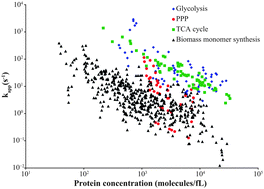Escherichia coli achieves faster growth by increasing catalytic and translation rates of proteins†
Abstract
Regulation levels of the gene expression cascade controlling

* Corresponding authors
a Tallinn University of Technology, Department of Chemistry, Akadeemia tee 15, 12618 Tallinn, Estonia
b
Competence Centre of Food and Fermentation Technologies, Akadeemia tee 15a, 12618 Tallinn, Estonia
E-mail:
kaspar@tftak.eu
Fax: +3726408282
Tel: +3726408200
c Tallinn University of Technology, Department of Food Processing, Ehitajate tee 5, 19086 Tallinn, Estonia
Regulation levels of the gene expression cascade controlling

 Please wait while we load your content...
Something went wrong. Try again?
Please wait while we load your content...
Something went wrong. Try again?
K. Valgepea, K. Adamberg, A. Seiman and R. Vilu, Mol. BioSyst., 2013, 9, 2344 DOI: 10.1039/C3MB70119K
To request permission to reproduce material from this article, please go to the Copyright Clearance Center request page.
If you are an author contributing to an RSC publication, you do not need to request permission provided correct acknowledgement is given.
If you are the author of this article, you do not need to request permission to reproduce figures and diagrams provided correct acknowledgement is given. If you want to reproduce the whole article in a third-party publication (excluding your thesis/dissertation for which permission is not required) please go to the Copyright Clearance Center request page.
Read more about how to correctly acknowledge RSC content.
 Fetching data from CrossRef.
Fetching data from CrossRef.
This may take some time to load.
Loading related content
